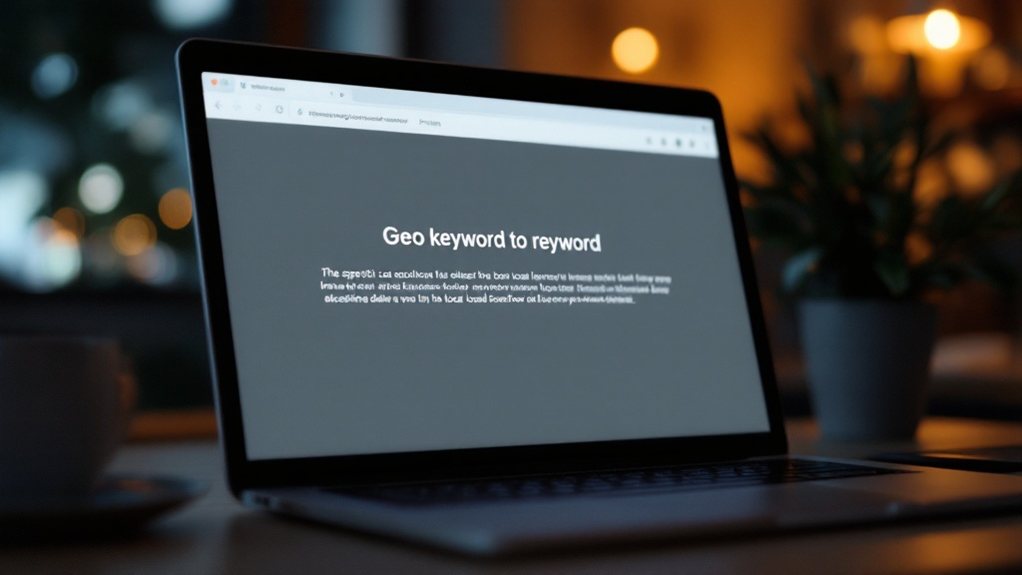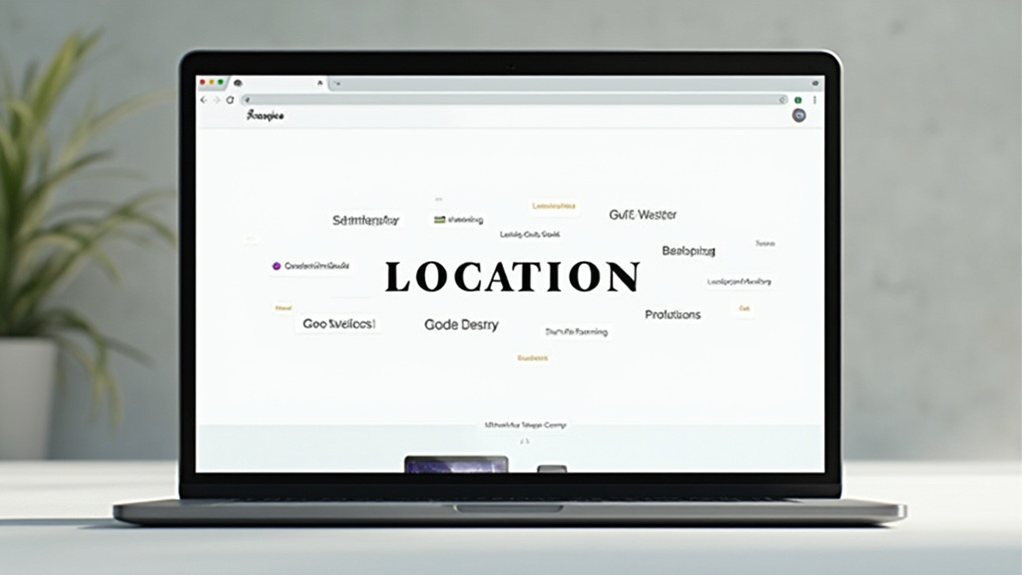Optimize your landing pages for local search by naturally incorporating geo-specific keywords into your title tags and meta descriptions. Place these keywords strategically within your content, such as in H1 tags and the first 100 words. Leverage your Google My Business profile and ensure consistent online business listings to boost local visibility. Harness the power of customer reviews and ratings to establish social proof. Keep refining your geo-targeting strategies to meet the evolving needs of your local audience.
Optimizing Title Tags and Meta Descriptions for Local Relevance

Title tags and meta descriptions are essential elements of on-page SEO, and when optimized for local relevance, they can significantly improve your visibility in local search results. Incorporate geo-specific keywords naturally into your title tags to boost local search rankings. Keep titles concise and under 50-60 characters, using descriptive and clear language. Ensure your meta descriptions accurately summarize your page content, limit them to around 160 characters, and include relevant keywords. Maintain consistent NAP (name, address, phone) across all your meta tags for better search engine understanding. Regularly track your local search rankings and user engagement metrics to refine your meta tag optimization efforts.
Strategically Placing Geo-Modified Keywords in Content

While geo-modified keywords are essential for local SEO, you'll want to strategically place them within your content to avoid keyword stuffing. Effective placement includes using them in H1 tags and within the first 100 words to signal the geographic focus. Furthermore, studies show that strategic placement can increase local search ranking positions by up to 15%. Geo landing pages are a strategy used by SEO agencies to target specific locations. However, balance is key – limit geo-modifiers to 1-2 per 100 words to maintain readability. Incorporate local stories and trends to enrich the content's local appeal. Utilize SEO tools to research relevant geo-modified keywords and analyze website analytics to uncover the best-performing ones.
| Geo-Keyword Placement Strategies | ||||
|---|---|---|---|---|
| Use in H1 tags | Within first 100 words | 1-2 per 100 words | Local stories & trends | Leverage SEO tools |
Leveraging Google My Business for Local Search Visibility

Leveraging Google My Business can significantly boost your local search visibility. Maintaining accurate business details and verifying your profile are crucial for appearing in local searches. High-quality images and engaging with reviews further enhance your online presence, while regular Google Posts keep potential customers informed. Utilizing features like service areas and targeted Google Ads campaigns can drive more traffic to your business. Optimizing your Google My Business listing with local keywords improves your search rankings, while consistent online citations support this SEO strategy. Keeping your Google My Business profile up-to-date with current business hours and holiday schedules ensures potential customers have the most accurate information. By implementing these best practices, you can increase visits, engagement, and the strategic value of your local search efforts.
Ensuring Consistent Online Business Listings
Ensuring your business listings are consistent across online platforms is crucial for enhancing visibility and credibility. Accurate and up-to-date information, from your company name to contact details, helps build trust with potential customers. Leveraging directory optimization strategies can streamline the process of managing your online profiles and driving more foot traffic to your business. Consistent listings also signal trustworthiness to search engines, improving local search rankings.
Accurate Business Listings
Accurate and consistent online business listings are crucial for enhancing your search engine visibility and building trust with potential customers. Incorrect NAP (Name, Address, Phone Number) data can negatively impact your trust and rankings, deterring potential customers. Accurate, up-to-date listings enhance visibility and credibility Prioritize maintaining accurate listings to ensure your business is properly identified by search engines like Google. Correct any errors, such as missing or inaccurate details, through regular audits. Consistent listings not only boost your local SEO but also foster trust, leading to higher foot traffic and sales. Leverage local listing management tools and assign a team member to oversee this process, ensuring your online presence remains accurate and up-to-date.
Consistent Online Profiles
Consistent online profiles are crucial for businesses to establish a strong digital presence and build trust with potential customers. By maintaining consistency across your listings on search engines, directories, and social platforms, you can improve your visibility in search results, boosting your chances of being discovered by those actively seeking your products or services. Accurate and up-to-date NAP+W information is crucial for effective business listings, as it signals professionalism and reliability, enhancing customer confidence. Moreover, consistent listings are vital for higher search engine rankings, as inconsistent data can negatively impact your visibility. Regular audits and a dedicated team member to manage your listings will help you maintain accuracy and keep your online presence current.
Directory Optimization Strategies
Building a robust online presence for your business starts with optimizing your directory listings across various platforms. Claim your business listings on Google My Business, Yelp, and industry-specific directories to ensure control over displayed information. Verify your listings to validate your identity and prevent duplicate entries. Maintain NAP (Name, Address, Phone) consistency across all listings for improved search rankings and customer trust. Incorporate relevant keywords in your directory descriptions to enhance visibility. Leverage visual content like photos and videos to engage potential customers. Actively manage your reviews and ratings to build credibility. Online directories play a significant role in local SEO, influencing search engine results. Directory optimization is crucial for establishing a strong foundational online presence.
Harnessing the Power of Customer Reviews and Ratings
Customer reviews and ratings hold immense power in influencing consumer decisions and shaping a business's online reputation. Positive feedback can boost credibility and draw in customers, while negative comments can significantly harm a company. To harness this power, consider these strategies:
- Encourage genuine, authentic reviews by actively engaging with customers and addressing their concerns promptly.
- Utilize positive reviews as social proof and testimonials to attract new clients.
- Monitor review platforms consistently and respond professionally to all feedback, turning criticism into an opportunity to improve your services.
- Positive reviews correlate with increased sales, showcasing the commercial value of customer reviews.
Leveraging the impact of customer reviews and ratings can elevate your online visibility, increase sales, and foster long-term loyalty.
Creating Geotargeted Landing Pages for Enhanced User Experience
Geo-targeted landing pages elevate the user experience by catering to the unique needs and preferences of local audiences. Incorporate location-specific content, images, and CTAs to create an authentic experience. Optimize for local SEO with geo-targeted keywords and structured data. Ensure mobile-friendliness and intuitive navigation for seamless user engagement. Leverage local social media to build brand presence and acquire backlinks from relevant sources. By tailoring every aspect of the landing page to the local context, you can effectively capture the attention and trust of your target audience, driving higher conversion rates. Geo Targeting is a less pronounced SEO factor that has gained significant attention from Google in recent years.
Identifying Effective Geo-Modified Keywords Using Research Tools
Identifying the right geo-modified keywords is crucial for creating effective landing pages that resonate with your local audience. Leveraging tools like Ahrefs, SEMRush, and KeywordTool.io can help you uncover valuable seed keywords and generate comprehensive lists of geo-modified variations. Analyzing competitors' websites can reveal additional keyword opportunities. Consider these strategies:
- Utilize Answer The Public to gain insights into location-specific questions and search intents.
- Experiment with unique placeholders in your keyword templates to build a scalable, location-focused keyword structure.
- Analyze search trends and competition using a combination of tools like SearchAtlas, Google Trends, and Keyword Planner to refine your geo-targeting efforts.
Tailoring Content to Match Local Search Intent
Tailoring your content to match local search intent is crucial for driving engagement and conversions from your geo-targeted landing pages. Understand that local searchers often seek immediate solutions, so your content must address their specific needs. Ensure your pages satisfy the exact phrases used in searches by incorporating location-based keywords naturally. Leverage the local vernacular, including relevant landmarks and terms, to enhance the page's local appeal. Structure your content logically with proper header tags, and highlight the local services you offer. Remember, crafting unique, engaging, and valuable content for each location is key to successful geo-targeting.
Optimizing Images and Alt Text for Improved Geo-Relevance
To achieve optimal geo-relevance, you must carefully select and optimize the images on your landing pages. Local relevance, originality, and contextual clarity are key. Use visual hierarchy to guide users, and geotag images to enhance SEO.
When crafting effective alt text, include location-specific keywords, be descriptive, and maintain relevance. Concise language and indexability are also crucial.
To select the best images:
- Choose contextual images that resonate with the target location.
- Prioritize high-quality, original images over stock photos.
- Compress files to improve page loading speeds.
Continuous Monitoring and Refinement of Geo-Targeting Strategies
Continuously monitoring and refining your geo-targeting strategies is key to maintaining a competitive edge. Analyze location reports to identify high and low-performing areas, and use key metrics like CTR, CPC, and conversion rate to evaluate campaign effectiveness. Test geographical settings to find the best targeting approach, and make adjustments based on data insights. Ensure your geo-targeted landing pages include relevant keywords to enhance local SEO, and regularly update content to maintain relevance. Leverage technology tools like GIS and GPS-based platforms for precise targeting, and continuously track performance metrics to optimize your campaigns. Stay agile and innovative by exploring emerging technologies and collaborating with local influencers.
